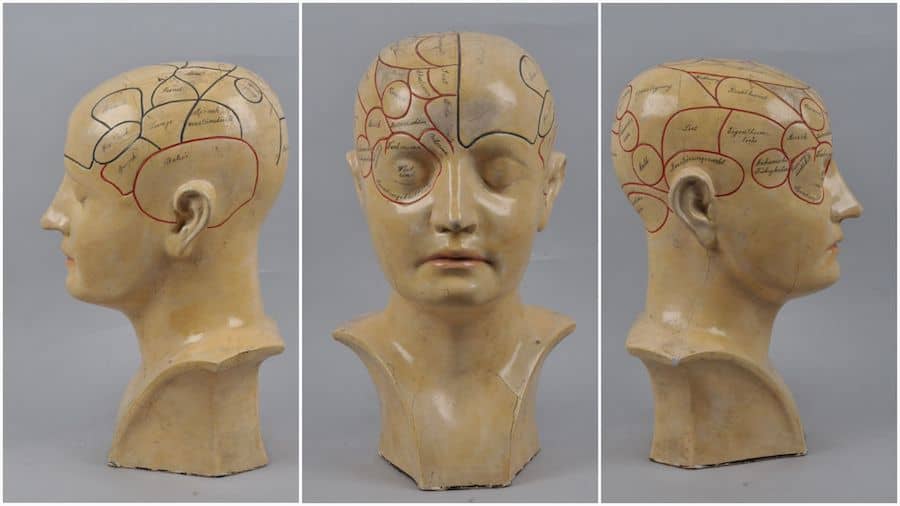
What can three skulls tell us about psychology?
Very few visitors of the University Museum in Groningen know that the three skulls exhibited there once belonged to Dutch gang members, and what they can tell us about the history and development of psychology and neuroscience.
The ceramic Fowler phrenology head is found on shelves in Psychology Departments around the world (see figure 1 below for an historic exemplar). But this is much more than a memento mori. Its origins illuminate the neurological history of the discipline. When I spotted one at the University Museum Groningen, I wasn’t aware how much it had to do with the three skulls exhibited in one of the nearby cabinets, nor did I expect their origin. The skulls provide a local connection, as well as a concrete manifestation of what would otherwise be only a set of abstract principles.
The collection manager, John Le Grand, explained to me that the skulls once belonged to members of the feared Zwartjesgoed (the Blacks) gang from the late 18th century. This gang consisted of both old and young men and women. Their brutal activities were so well-known in the Dutch community that they even became the subject of story and song. Their violence is known even today. An especially famous case is the murder of a Groningen skipper. After gaining his confidence in a tavern, he was robbed of his money, his watch, and his silver buttons, and brutally stabbed to death in 1805. His killer, Hanna Broens, was a minor at the time. And so, although initially sentenced to death, she asked for leniency. Her death sentence was then revoked, eventually by Napoleon’s brother—who had just recently become King of Holland (Egmond, 1993).
Right around that same time, Franz Joseph Gall (1758-1828) was examining inter-individual differences of behaviour in relation to the physiology of the brain. To observe extreme behaviors, Gall visited jails, shelters, and schools.
He dissected brains, investigated brain lesions, and explored how skull features might be associated with personality traits and cognitive skills (Eling & Finger, 2019). Based on these studies, against the then-prevailing assumption that the cortex was uniform in its function, Gall proposed the “Schädellehre” (doctrine of the skulls), a revolutionary idea of cortical modularity and localized cognitive functions (Eling & Finger, 2015).
Figure 1. Exemplar of the ceramic Fowler phrenology heads from the University Museum Groningen
Gall’s student Johann Spurzheim (1776-1832) extended Gall’s Schädellehre and introduced the term “phrenology”. He also published in English, thereby reaching a larger audience. Phrenology was well received by physicians worldwide (Eling & Finger 2019). There was wide interest, especially for the alleged importance of head shape for diagnosing and predicting mental abilities and personality, with potential implications for application in diverse domains. Not long after, phrenology charts were released and widely used. Practicing phrenologists analyzed their clients by running their fingertips over the head or using instruments such as measuring tapes and calipers to distinguish skull elevations or indentations.
Phrenology became very popular. At its height, businessmen would make lucrative deals by skull-reading, employers could request a phrenology-based character reference from their employees (Cooter, 1984). Darwin, for instance, almost didn’t get to go on his Voyage of the Beagle because Captain Fitzroy believed in the power of physiognomy, a variation of phrenology.
Even children were not spared (Cooter, 1984). In an autobiography of the late 19th century, the writer remembers vividly the advice of being “better adapted to the quietude of rural life rather than to the habit of letters” after having been “felt on the head” during his school time (Renkin, 1912). The American brothers Lorenzo and Orson Fowler, two leading phrenologists and businessman, were those who developed the Fowler phrenology head, which became the symbol of this discipline (see Figure 1). However, the practice was not universally accepted: even during that time phrenology was considered by some “a piece of thorough quackery from beginning to end” (Gording, 1815). This is of course consistent with the view today (see e.g., Parker Jones et al., 2018). Therefore, Parker Jones et al. (2018) suggested that any phrenology head decorating our office desks should rather be left blank.
Nonetheless, while Gall’s arguments about the relevance of skull morphology have long since been abandoned by the scientific community, Eling and Finger (2019) have argued that, overall, Gall “was more right than wrong”. This is easier to recognize when we see that two famous researchers each made celebrated scientific breakthroughs as a result of considering Gall’s arguments regarding localization.
More specifically: by examining a patient who had language difficulties, Paul Broca (1824-1880) identified the left inferior frontal gyrus of the brain as crucially important for speech production in 1861. Similarly, in 1874, Carl Wernicke (1848-1905) identified the left superior temporal lobe of the brain as critically important for understanding the meaning of words. In other words, Gall’s research was imperative for the early development of psychology and neuroscience.
So how did the skulls of three Zwartjesgoed gang members end up in the University Museum Groningen? Unlike Hanna Broens, several Zwartjesgoed gang members were eventually arrested and sentenced to death in The Hague. Their bodies were dissected by Pieter de Riemer, a local physician and anatomist, who met Gall in 1806 (Le Grand, 2013). Later, the de Riemer Collection was given to the University of Groningen after the closing of the predecessor to what is now The Hague University of Applied Sciences. Only in 2006, portraits of the gang members came to light (see Figure 2), which is an exceptional discovery as they had been depicted just by coincidence, probably in their jail cell (Le Grand, 2013). Ultimately, the Zwartjesgoed skulls certainly are more than just 200-year old bones; they are a gateway to the discipline’s past.
Figure 2. Portraits of three Zwartjesgoed members from the University Museum Groningen
Combe, G. (1835). Elements of phrenology. Boston: Marsh, Capen & Lyon.
Cooter, R., (1984). The cultural meaning of popular science: Phrenology and the organization of consent in nineteenth-century Britain. Cambridge: Cambridge University Press.
Egmond, H. (1993). Children in Court: Children and Criminal Justice in the Dutch Republic. Social & Legal Studies, 2, 73-90.
Eling, P, & Finger, S. (2015). Franz Joseph Gall on greatness in the fine arts: A collaboration of multiple cortical faculties of mind. Cortex, 71, 102-115.
Eling, P, & Finger, S. (2019). A commentary on Parker Jones et al. On Gall’s cortical faculties. Cortex. 5, 345-347.
Evrengun, H., & de Fijter (2002). De georganiseerde misdaad In Nederland. Historisch Neuwsblad (1). Retrieved July 10, 2019 from: https://www.historischnieuwsblad.nl/nl/artikel/5822/de-georganiseerde-misdaad-in-nederland.html
Gordon, J. (1815). The doctrines of Gall and Spurzheim. Edingburgh Review, 25, 227-268. Retrieved July 16, 2019 from: http://www.historyofphrenology.org.uk/texts/gordon.htm
Le Grand, J. (2013). Bony Stories. Papers on Anthropology, 309-317.
Parker Jones, O., Alfaro-Almagro, F., & Jbabdi, S. (2018). An empirical, 21st century evaluation of phrenology. Cortex, 106, 26-35.
Parker Jones, O. (2019). Neuroimaging’s 19th century debts. Cortex, 115, 348-349.
Rankin, G.C. (1912).The Story of My Life Or More than a Half Century as I Have Lived It and Seen It Lived-Or more than a half century as I have lived it and seen it lived. Neshville, 123-4. Retrieved July 12, 2019 from: https://archive.org/details/storyofmylifeorm00rank/page/n139
Staum, M S. (2003). Labeling People: French Scholars on Society, Race and Empire, 1815-1848. Montreal: McGill-Queen’s University Press.
Van Wyhe, J. (2011). The History of Phrenology on the Web. Retrieved July 12, 2019 from: http://www.historyofphrenology.org.uk/overview.htm





